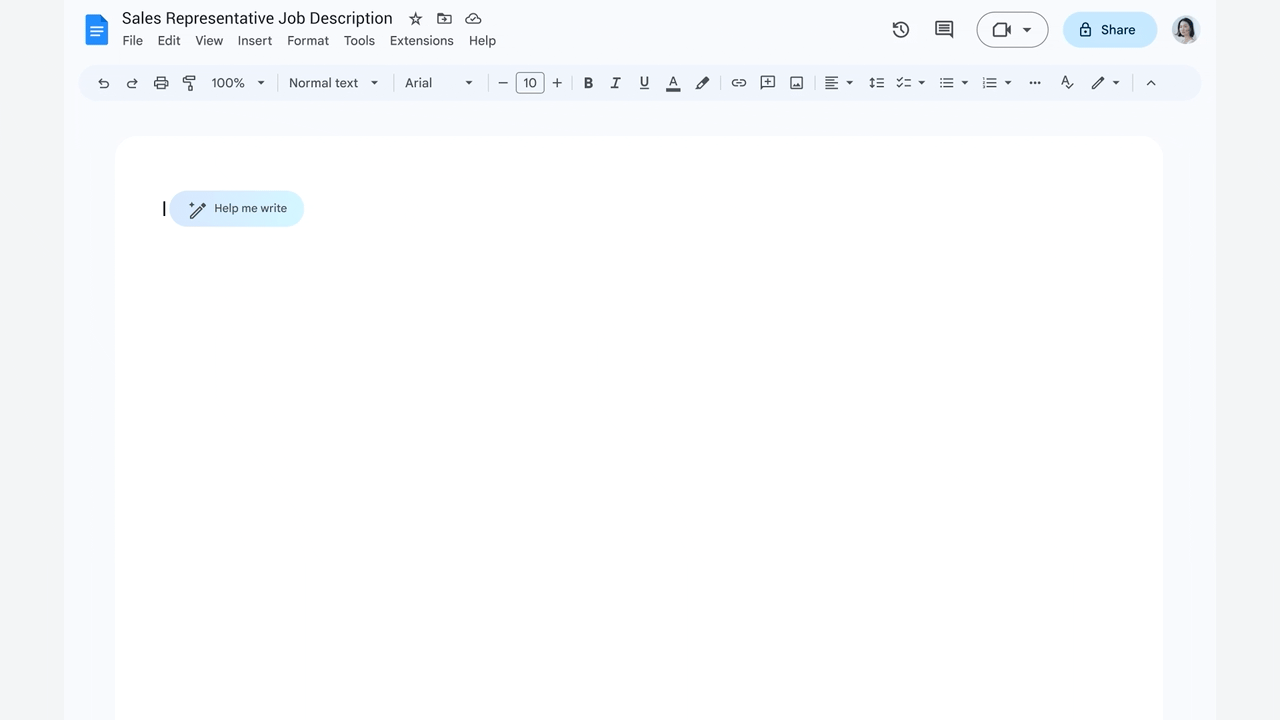Better business: New tools put generative AI to work across industries

Carrie Tharp
Vice President, Strategic Industries, Google Cloud
New Google Cloud offerings unveiled at Google I/O can help organizations capitalize on generative AI today, in creativity, collaboration, and coding.
Across industries, many business leaders have talked about their organizations becoming technology companies. Today, that conversation has taken a new form: how to become AI-enabled companies, with tangible business results to show for it.
Ultimately, companies are still primarily defined by their core offerings — whether that’s a financial institution providing a bank account, a retailer creating this season’s new hot outfit, or a hospital offering life-saving surgery. Core differentiators will remain the same, but successful businesses in the future will be those that can apply AI practically to tackle some of their most common, time-intensive, real-world problems.
To help businesses reach their full potential with generative AI technology, Google Cloud unveiled a number of enterprise-focused products and services at Google I/O this week.
There were many products and features shared at I/O — Google’s biggest developer event of the year. To highlight some of them, leaders and decision-makers across key industries will likely see immediate potential in the exciting new features in Vertex AI (Google Cloud’s AI platform), the ability to collaborate with AI in Google Workspace, and the launch of Duet AI for Google Cloud. Here’s how …
Scale creativity with pictures from less than a thousand words
Developers and businesses can now use Google Cloud’s Vertex AI platform to build and deploy machine learning models and AI applications at scale. And three new foundational models in Vertex AI will enable businesses to innovate in entirely new ways.
With the introduction of Imagen, our text-to-image foundation model on Vertex AI, organizations can generate and customize studio-grade images at scale for their business needs, from promotional material to concept designs. With this new capability, a user’s text prompt can create and edit high-quality images with low latency and enterprise-grade data governance that helps protect internal information and queries.
For example, a consumer goods brand could generate packaging designs and ad images based on text prompts on seasonal trends, while a fashion designer could generate custom images for marketing to resonate with an individual's style preferences and shifting consumer tastes. A life sciences researcher could describe a molecule with desired traits to generate an image, which can be used to visualize differences between molecules, helping to inform research.
A business can upload its existing images, with security and governance controls already built into Vertex AI, to help keep its data safe. And any image created on Vertex AI remains the customer’s data and can be used by the organization as they see fit.

New ways to code effectively and reach customers globally
Businesses across different industries increasingly rely on top engineering talent, with many reporting the availability of coders as a limitation on their growth. For example, auto manufacturers employ expert programmers whose code now serves as the foundation for vehicles. Media companies rely on their developers to create enjoyable streaming experiences.
Our announcement of Codey, a foundational model for text-to-code on Vertex AI, will help developers across industries with real-time code completion and generation capabilities, customizable to a company’s own codebase. It supports 20-plus programming languages and helps developers work smart and fast with three crucial capabilities:
Code completion: Codey suggests the next few lines based on the context of code entered into the prompt.
Code generation: Codey generates code based on a developer’s natural language prompts.
Code chat: Developers can converse with a bot to get help with debugging, documentation, learning new concepts, and other code-related questions.
We see immense applications for this new capability as it helps scale the capacity of companies’ existing engineering resources. For example financial services companies often require high-performance computing for tasks like risk calculations or market simulations. Codey can help developers optimize code for parallel processing, GPU acceleration, and other performance-enhancing techniques. In the code-intensive media industry, Codey can accelerate code development for streaming platforms that require complex integration of disparate systems, such as content processing and subscriber management.


We also unveiled Chirp, a foundational model for speech-to-text on Vertex AI, which will help businesses and organizations engage customers in their native languages and accents.
Trained on millions of hours of audio, Chirp is a new version of our 2 billion-parameter speech model that supports more than 100 languages and brings the model quality of the world’s most widely-spoken languages to scores of additional languages and dialects. Chirp achieves 98% accuracy on English and relative improvement of up to 300% in languages with less than 10 million speakers.
Media companies can use it to caption movies spoken in Xhosa, the official language of South Africa and Zimbabwe. A retailer can leverage Chirp to enable an automated customer service agent to better understand a diversity of accents and provide broader voice assistance as they expand commerce to new geographies. Banks can provide advisory services to customers in multiple languages, enabling them to scale their services and encourage financial inclusion.
Evolve your generative AI models responsibly
What makes large language models (LLMs) so impressive is their ability to generate diverse and compelling text from input prompts. But what makes an LLM’s output “good” can be hard to define. Ultimately, it’s up to the end user’s subjective opinion and the task at hand, whether it’s a writer developing a keynote script, a researcher looking for accurate information, or a developer in need of reliable code.
Google Cloud is now offering businesses a capability called reinforcement learning from human feedback (RLHF). With this offering in Vertex AI, customers in our trusted tester program can give human feedback to their LLMs on whether their output to various prompts is realistic, safe, and gets to the sense of what’s being asked. This capability allows an organization to update and tune their models to create a specific sounding voice — an important feature for many well-known brands — and review model responses for biased and toxic content, teaching the model to avoid inappropriate outputs.
We see RLHF as being particularly impactful in industries where accuracy is critical, like healthcare, or where customer satisfaction is a differentiator, such as financial services and retail.
For example, a healthcare provider can use this capability to take a hands-on approach in ensuring its new generative AI chatbot is consistently assisting patients with a helpful and compassionate tone. A consumer packaged goods company could tune its chatbot to speak with a clear brand voice and apply customer service policies in the context of an individual’s specific requests, like managing a return. Financial institutions can continuously improve customer service for increasingly complex queries and provide hyper-personalized digital banking experiences that are effective, accurate, and helpful.
Do your best work in Workspace with generative AI
Every business is also trying to get the most from the office productivity tools their teams count on daily. Now with Duet AI for Workspace, anyone in your workforce can collaborate in real time with AI. Workers and organizations can:
Get help writing, even on the go: We’re adding the ability for trusted testers to draft AI-generated responses that take the context of an email thread into consideration while on a mobile device. This could be used to summarize an email thread discussing perspectives around marketing claims or catch up on a long string of interaction on the upcoming product launch.
Generate images from text in Google Slides and Google Meet: Users can easily generate images from text descriptions to create a compelling presentation. Just imagine this being used in pitch presentations from banks to personalize content for a prospective customer’s expanding small business.
Classify data and organize complex projects automatically in Google Sheets: Using Sheets, you can now automate data classification and the creation of custom templates, helping analyze and organize data fast. For instance, this could help a data analyst for an auto manufacturer organize and categorize data coming in from many different car dealerships, flagging something like critical quality issues in the field. A market researcher for a financial institution could extract information from annual reports to efficiently create research and identify market trends.
Accelerate workflows with AI-powered templates in Google Docs. Smart chips, variables, and templates are now automatically woven into content generated in Docs, which gives people actionable shortcuts. Someone who might find this helpful is a hiring manager for a fashion brand, who can quickly produce a detailed job description from a relatively simple prompt.


Pioneering the future of AI
Each of these cloud-based AI products announced at I/O help enterprises of various sizes across all sorts of industries boost creativity and productivity, and do so responsibily. Ultimately, we know it’s not about what our technology can do, but how it can help businesses efficiently address their unique challenges and realize real value.
Codey, Imagen, and RLHF are now available in Vertex AI through our trusted tester program, and Chirp is available in preview in Vertex AI to everyone with a Google Cloud account. And the best way to learn more about AI in Workspace is to use it, which is why we’ve launched Workspace Labs as a trusted tester program where you can try out these new experiences.
If you’re interested in going deeper on the journey of bringing more AI into your business, you can get started here.



